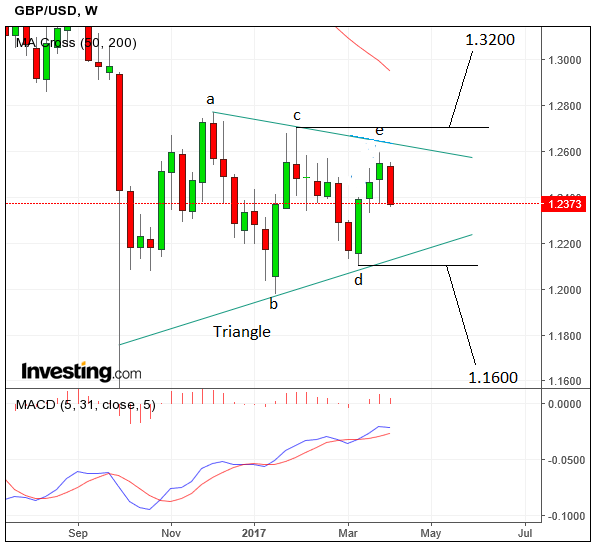GBP/USD Rate 5-Day Forecast: Moving Lower and Targeting 1.2200

GBP/USD has been trading sideways since last autumn as Brexit uncertainty has pushed sentiment one way and then the other, leading to the exchange rate oscillating between roughly 1.2700 and 1.2000.
Now the pair looks like it is starting a new leg lower and could target 1.2200 in the coming week.
On the daily chart a double top pattern has formed and the exchange rate is currently breaking through the pattern’s neckline providing downside triggering confirmation.
Double tops resemble ‘M’ shapes, with the ‘neckline’ at the level of the intervening trough between the two peaks. When the neckline is breached, the pattern is confirmed and is henceforth expected to reach a downside target equal to the height of the double top extrapolated lower from the neckline.

In this case that gives a target at 1.2200, which is also at the level of the triangle’s lower boundary line.
The larger triangle pattern is more clearly seen on the weekly chart below. It has now probably completed after finishing five component waves (a-e).
It will now probably breakout either higher or lower. The target to the upside is 1.3200, signalled by a move above the February high; the downside target is at 1.1600 and would be triggered by a move below the March lows.
The Dollar this Week: More Strength Likely
The US Dollar rebounded after losing ground immediately following the release of Non-Farm Payrolls, which showed a lower-than-expected 98k new jobs added.
US yields turned higher following the release as markets priced in further US Federal Reserve interest rate rises.
This, “seems to be offering the USD tactical support that may last in the near-term,” says a note from UniCredit at the start of the new week. “US yield developments appear to be turning USD-positive, and, although too much is priced-in to the Dollar, the rise in US yields is likely to lend some further support to the greenback in the short term.”
Improving relations between Donald Trump and President Xi seemed to have also assisted the Dollar's recovery.
Trump said he felt there was “tremendous progress” during his talks with the Chinese leader, and added he believes “lots of very potentially bad problems will be going away” as a result of improved relations between the two countries.
For himself, Xi said he received a warm reception from members of the Trump administration and the two sides came to “many understandings” after holding “in-depth and lengthy communications.”
As far as hard data in the week goes, this week kicks off with JOLTS Job Openings in February at 15:00 on Tuesday 11, and more investors may be watching this figure than usual, given the lacklustre payrolls data last Friday.
The next major release after that will be CPI for March on Thursday, with Core CPI forecast to slow to 0.2% from 0.3% in the previous month.
Michigan Consumer Sentiment is out on Thursday evening, meanwhile, and is forecast to come off highs and show a decline to 96.6 from 96.9 previously.
Two Big Data Releases Ahead for the Pound
While New Zealand has little on the calendar we have some big releases in the UK, and this is where any potential moves in GBP/NZD are likely to be derived.
“In the run up to Easter, we suspect we will see a relatively quiet period for political news, with few top tier political events,” says Victoria Clarke at Investec in London.
“With the Easter holidays approaching and with UK Parliament in recess, there is likely to be little by the way of major developments in Brexit talks over the coming week.”
Luckily, for those looking for the Pound to move we have some big data events ahead.
“With fewer political happenings, data will likely move to the fore next week,” says Clarke. “In the UK, data is likely to take centre stage too.”
CPI inflation figures for March are due out Tuesday morning; markets expect to see inflation at 2.3%, unchanged on the previous month’s reading.
Should inflation beat expectations we would anticipate the Pound to move higher.
But we think the core CPI reading will be more important as this presents a better reflection of the underlying strength of UK economic activity and is therefore the figure that would most likely interest decision-makers at the Bank of England.
Markets are forecasting core CPI to read at 1.9%, a little softer than the 2.0% reading seen in the previous month.
Again, should this number beat expectations then look for the Pound to jump.
Labour market data is the next big data event foreign exchange traders will be keeping an eye on and is due for release at 09:30 on Wednesday, April 12.
The claimant count is expected to fall by 3K while the unemployment rate is forecast to remain static at 4.7%.
But watch average earnings data as this is what gives a really good gauge as to the health of the economy and the potential spending power of the UK consumer.
Average earnings with bonuses included is forecast to publish at 2.2%, unchanged on the previous month’s reading.
If the figure comes in higher we would imagine the Pound will move accordingly and we would watch for the GBP/USD exchange rate to edge upwards.
Disappointment will likely be punished and we would anticipate GBP/USD slumping back into the mid part of recent ranges.





